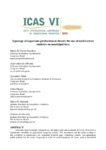Please use this identifier to cite or link to this item:
http://www.alice.cnptia.embrapa.br/alice/handle/doc/970198| Title: | Typology of sugarcane production in Brazil: the use of multivariate statistics on municipal data. |
| Authors: | FASIABEN, M. do C. R.  OLIVEIRA, A.   MAIA, A.   MARIN, F.   ALMEIDA, M.   OLIVEIRA, O. de   |
| Affiliation: | MARIA DO CARMO RAMOS FASIABEN, CNPTIA; ARYEVERTON FORTES DE OLIVEIRA, CNPTIA; ALEXANDRE MAIA, Unicamp; FABIO RICARDO MARIN, CNPTIA; MAXWELL ALMEIDA, IBGE; OCTÁVIO DE OLIVEIRA, IBGE. |
| Date Issued: | 2013 |
| Citation: | In: INTERANTIONAL CONFERENCE ON AGRICULTURAL STATISTICS, 6., 2013, Rio de Janeiro. Improving Statistics for Food Security, Sustainable Agriculture, and Rural Development Rio de Janeiro: IBGE, 2013. |
| Pages: | p. 1-16. |
| Description: | Abstract: Given the large territorial extension and the high social and economic diversity, Brazil has a remarkable variability in agricultural cropping systems. The description and the understanding of this variability is fundamental for proposing research gaps, technology transfer and appropriate public policies for the sector. Sugarcane is used for several purposes on farms, such as household consumption, energy and sugar production, and forage production. Data collected during the 2006 agricultural census, accomplished by the Brazilian Institute of Geography and Statistics (IBGE), shows that 192,931 farms (3.7% of Brazilian farms) reported having grown sugarcane in 2006. This paper addresses the classification and characterization of the sugarcane producing municipalities in Brazil, using techniques of multivariate statistical analysis (factor and cluster analysis). The 41 variables used were created from the data collected by the 2006 agricultural census, covering 3,576 municipalities. Data went through a sugarcane filter, and was then regrouped by municipality. Those variables gather socioeconomic and technological information on the farms, such as land usage, harvested area, production goal, productivity, input usage, use of industrial wastes, irrigation, source of producer?s income, percentage of the income that comes from sugarcane, family or conventional farming, size of herds, distance from the farms to sugar mills, among the most important. Analyses identified 9 different groups of sugarcane production in the municipalities, remarking large variability of sugarcane sector in Brazil, and the clear spatial differences of production and technology use in the territory. The results of the statistical analysis and the characteristics of the groups were discussed among scholars specialized in sugarcane research and were considered coherent with Brazilian reality. |
| Thesagro: | Análise Estatística Estatística |
| NAL Thesaurus: | Statistical analysis Cluster analysis Statistics Sugarcane |
| Keywords: | Cana-de-açúcar Tipologia |
| Notes: | ICAS VI. |
| Type of Material: | Artigo em anais e proceedings |
| Access: | openAccess |
| Appears in Collections: | Artigo em anais de congresso (CNPTIA)  |
Files in This Item:
| File | Description | Size | Format | |
|---|---|---|---|---|
| tipology.pdf | 3.44 MB | Adobe PDF |  View/Open |









